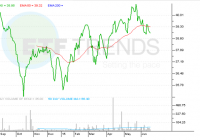Drivers Of ROE In The Context Of Portfolio Management
Someone on the Corner of Berkshire and Fairfax message board recently posted this comment referencing Buffett’s well-known piece on inflation from 1977 . In the article, Buffett describes the variables that drive a company’s return on equity. There are only five ways that a company can improve returns: Increase turnover Cheaper leverage (reduce interest charges) More leverage (increase the amount of assets relative to a given level of equity) Lower income taxes Wider margins Notice three of the five drivers of ROE have to do with taxes and leverage. So the pretax returns (as opposed to capital structure variations) are really driven by just asset turnover and profit margins. Some executives at the DuPont Corporation (NYSE: DD ) also noticed these drivers in the 1920s when analyzing their company’s financial performance. They broadly categorized the drivers as turnover, margins, and leverage. For now, I want to leave leverage out of it and think about turnover and margins. Portfolio Turnover I wrote a post a while back discussing the misunderstood concept of turnover in the context of portfolio management. Specifically, the topic of realizing gains (and paying those dreaded taxes). Basically, the idea of short-term capital gains is taboo among many value investors. I think it’s very important to try and be as efficient as possible with taxes. However, I think that tax consideration is only one of the (not the only) factors to consider. We could take Buffett’s five inputs that increase or decrease a company’s ROE and apply them to the portfolio. Basically, as investors, we are running our portfolio just like a business . We have a certain level of equity in the portfolio, and we are trying to achieve a high return on that equity over time. The exact same factors that Buffett talks about above apply to our portfolio. Those five factors are the inputs that will increase or decrease our portfolio ROE (aka CAGR) over time. Notice that taxes is one of the (but not the only) factors. Turnover is also one of the (but not the only) factors. Michael Masters is not a value investor, but he runs a fund that has produced fabulous returns over the past 20 years or so (from what I’ve read, north of 40% annually). You can read about him in the book Stock Market Wizards by Jack Schwager . Now, I don’t understand his specific strategy, and I’m not suggesting it’s one that should be cloned, or copied, etc… I’m just focusing on the turnover concept here. Masters, according to the interview, runs a strategy focused on fundamental catalysts, and holds stocks an average of 2-4 weeks. When he was running a smaller amount of money, he was compounding at 80%+ per year. Of course, he was paying a lot of taxes. His investors – the ones in the highest tax bracket – might be “only” netting 40% or so after tax. But who would be upset with paying a lot of taxes if it means achieving a 40% return on the equity in your capital account? Obviously an extreme example, but the concept illustrates the point that just because you hold stocks for years and years and pay very low taxes doesn’t mean that your after tax ROE will be any better than an investor who pays a lot of tax and achieves a much higher pretax return. I think it’s very difficult to compound capital at 20% or more without some amount of turnover in the portfolio. This doesn’t mean I’m promoting higher levels of activity. I’m not. I think making fewer decisions is often better, and trying to do too many things is very often counterproductive. I’m just saying that the math suggests that some level of turnover is needed if your goal is to compound capital at north of 20% over time. This is one of the reasons I love bargains and deep value special situations in addition to the compounders. As I’ve said before, very few companies compound their equity and earnings at 20% or more over years and years. Those that do often are priced expensively in the market. But to achieve portfolio returns of 20% without paying taxes, you’d have to not only properly identify these companies in advance, but you’d have to have the foresight to invest your entire portfolio in them. How Did Buffett and Munger Achieve Their Results? It’s a difficult proposition to be able to seek out in advance the truly great compounders that will compound at 20%+ for a decade or more, and that’s why investors who focus on bargains and special situations often are the ones with the extreme performance numbers (like Buffett doing 50% annual returns in the 50s, Greenblatt doing 40% annual returns in the 80s and 90s, etc…). It’s unlikely to do 20% annual returns by buying and holding great businesses for a decade without selling. It’s basically impossible to do 30%+ without ever selling. Charlie Munger has promoted the idea of low turnover – and I think his reasoning (as usual) is very sound, but I think he was using the Washington Post as an example – and I think that might be (dare I say) somewhat biased in hindsight. But if you’re looking for decent after tax returns, he’s right. If you can find a company that compounds at 13% per year for 30 years, you’re going to achieve good after tax returns on your capital. But, I think finding the Washington Posts of the world are easier said than done in hindsight, especially when thinking about a 30-year time horizon. Another example I’ve discussed before is Disney (NYSE: DIS ). Buffett bought Disney for $0.31 per share and sold a year later for a 50% gain in the mid-60s. He laments that decision as a poor one, but in fact his equity has compounded at a faster rate than Disney’s stock over time, making his decision to sell out for $0.50 a good one. And that is an extreme example using probably one of the top 10 compounders of all time. Not every stock is a Disney, thus making the decision to sell at fair value after a big gain in a year or two much more likely to be the correct one. Back to Munger’s Washington Post example… I like to consider his audience. I don’t necessarily think he was saying this is the highest way to achieve attractive investment results. My guess is he was trying to convey the importance of long-term thinking and lower turnover. However, when Munger ran his partnership, he was trying to compound at very high rates, and for years did 30% annual returns. He didn’t do this by buying and socking away companies like the Washington Post. He may have had a few ideas like that, but he was a concentrated special situation investor who was willing to look at all kinds of mispriced ideas. Buffett/Munger of Old vs. New I think there is a disconnect between the Buffett/Munger of old, and the Buffett/Munger of today. Their strategies have obviously changed, and their thinking has evolved. But their best returns were in the early years when they could take advantage of the (often irrational) pricing that Mr. Market offered. They were partners with the often moody Mr. Market back then and they took advantage of his mood swings. When they came into the office and Mr. Market was downtrodden, they’d buy from him. And on the days when Mr. Market was excited and overly optimistic, they’d sell to him. Their bargain hunting days provided them and their investors with 20-30% annual returns. They made a lot of money. They paid a lot of taxes. As they compounded capital, they began to evolve. Buffett and Munger both have discussed this, but they both have said with smaller amounts of capital, they’d invest very differently. Buffett bought baskets of Korean stocks in his personal account in 2005 when some were trading at 2 times earnings with net cash on the balance sheet. He’s also done arbitrage situations, REIT conversions, and other things in his personal account that provided attractive, low-risk returns (and very high annualized CAGRs). By the way, this is not an indictment against compounders. As I’ve mentioned before, my investments tend to fall into one of two broad categories: compounders and special situations/bargains. I actually enjoy investing in compounders the most, since they do the work for you. But bargains are the ones that often get more glaringly mispriced for a variety of reasons (not the least of which is the fact that the compounders are great businesses – and everyone knows they are great). But I don’t have a dogmatic approach to investing, and I will look for value wherever I can find it. I’m not sure if this post really has a hard conclusion and maybe this is more of a ramble than anything else. I’m not sure how to sum it up, so I’ll just stop here. These are just observations I have had, and the COBF post on Buffett’s 1977 piece ( which is a great piece to read if you haven’t ) prompted some of these thoughts which I decided to write down and share. I think it’s important to understand the drivers of investment results (portfolio returns on equity) are the exact same factors that drive the ROE of a business. Feel free to add to the discussion if you’d like. Have a great week, and for the golf fans, enjoy the US Open.

